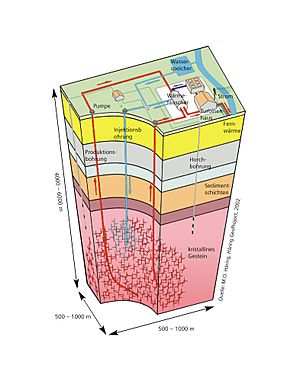Enhanced geothermal system facts for kids
An enhanced geothermal system (EGS) is a special way to get geothermal energy from deep inside the Earth. Geothermal energy uses the natural heat from our planet. For a long time, we could only get this energy in places where hot rocks, underground water, and cracks in the rocks all came together naturally.
But now, EGS lets us create our own "hot spots" for energy! This means we can make electricity even in places where there isn't natural underground water or enough cracks in the rocks. People can change these areas to make them work for energy. EGS allows us to get geothermal power in more places, not just near active plate boundaries.
Contents
How EGS Works: A Step-by-Step Guide
Getting energy from an enhanced geothermal system involves a few important steps.
Finding the Right Spot
First, scientists need to study the land very carefully. They look for:
- How hot are the rocks deep underground?
- Are there any natural cracks or "fractures" in the rocks?
- Is there any water already underground?
- What changes are needed to make a good EGS power plant?
Making the System Work
Once a good spot is found, the real work begins!
Drilling Deep Wells
To reach the hot rocks, special holes, called wells, are dug thousands of meters deep into the Earth. These wells are placed carefully, not too close to each other, so they don't "steal" heat from one another.
Creating Cracks and Water Flow
Next, water is pumped down these wells at a controlled speed. This water helps create new cracks or re-open old ones in the hot rocks. This process is similar to fracking, where water pressure causes tiny shifts in the rock. These shifts are usually too small to be felt on the surface.
Once a good network of cracks is made, the water flows through them. As it moves, the water gets super hot from the Earth's heat.
Getting the Hot Water Out
The super-heated water is then pumped back up to the surface through another well, called a production well. This hot water goes to a power plant, where its heat is used to make electricity. After giving up its heat, the water is sent back down into the Earth to get hot again. This way, the water is used over and over!
Guiding the Water
To make sure the water flows correctly towards the production well, tiny "microholes" can be drilled. These small holes, less than 4 inches wide, help connect the cracks in the right way for the best energy production.
Running the Power Plant
After the system is set up, the power plant can start making electricity. Engineers and scientists then work to keep the plant running smoothly and safely.
EGS: A Green Energy Choice
Enhanced geothermal systems are considered a very clean way to make energy.
Reusing Old Wells
One cool way to make EGS even better is by using old oil and gas wells. Instead of drilling new holes, we can change these old wells to "mine" heat from the Earth. This is often cheaper than digging brand new wells.
These recycled wells work a bit differently. They have two pipes, one inside the other. Water is pumped down between the two pipes, gets hot, and then comes back up through the inner pipe. Because the water doesn't directly touch the hot rocks, and some heat can escape, these systems might not produce as much energy as new EGS plants. But it's a great way to reuse old sites!
Low Emissions
Many experts say that geothermal energy is one of the "greenest" alternative energies available. Some types of geothermal power plants, like flash-steam and dry-steam systems, release less than 7% of the greenhouse gases that fossil fuels do. Another type, called a closed binary-cycle system, releases almost no greenhouse gases at all!
The main time EGS systems create emissions is when drills are powered by diesel fuel during construction. However, studies show that connecting the drills to the electric power grid can greatly reduce this small impact. This makes EGS even better for human health, climate change, and the environment.
Supporters also like that geothermal energy doesn't depend on the weather, like solar or wind power. This means it can provide a steady and reliable source of electricity all the time.
EGS in the United States
The United States has a huge amount of potential geothermal energy, more than any other country. However, only a small part of its total energy (about 4%) comes from geothermal power plants.
California uses the most geothermal heat pumps in the US. Hawaii gets a big chunk of its power (20%) from geothermal plants. Even with this potential, many people don't know much about geothermal energy. This makes it hard to get money for research and development.
Developers sometimes face challenges getting permission to drill on public land and getting funding from the government or private companies. But there have been efforts to help EGS grow. For example, laws like the Energy Act of 2005 and the Energy Independence and Security Act of 2007 have offered tax credits and supported research programs to help this important energy source move forward.
Images for kids
-
Geothermal power technologies.




